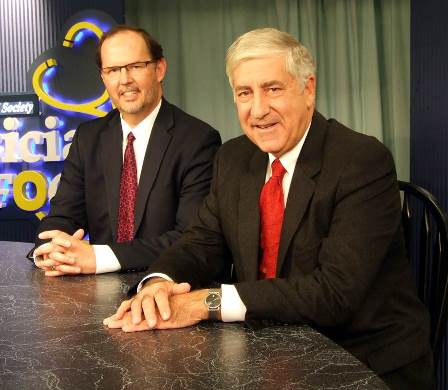Smoking, Tobacco, and Health
January 6, 2014
From Massachusetts Medical Society, Physician Focus
By Alan Woodward, M.D. and Douglas Ziedonis, M.D., M.P.H.
The 50th Anniversary of the U.S. Surgeon General’s first report on smoking and health is cause for renewing efforts against smoking and tobacco.

Douglas Ziedonis, M.D., M.P.H. (left) and Alan Woodward, M.D. (right)
January 2014 marks the 50th anniversary of the U.S. Surgeon General’s first comprehensive report on the dangers of smoking and tobacco, a landmark document that signaled the start of the nation’s public health campaign against tobacco and its health consequences.
Since that first effort in 1964, thirty-six additional reports on tobacco from the Surgeon General have followed, testifying to the topic’s critical importance. Many have focused on children, women, second-hand smoke, and specific conditions such as heart and lung disease, cancer, and nicotine addiction.
The connection between tobacco – cigarettes, cigars, smokeless tobacco, and second-hand smoke – and disease is clear, convincing, and undeniable. Tobacco use is linked to a multitude of health problems, from conditions as severe as cancer and heart and lung diseases to diseases specific to fetuses, diabetes, poor wound healing, and even wrinkles. The highly addictive nature of nicotine, due to its effects on specific areas of the brain, is now also well known.
We have made great progress over five decades in reducing tobacco use. Successful prevention and treatment strategies have been developed. We now have seven FDA-approved medications for tobacco addiction treatment, cognitive-behavioral treatments, and excellent community resources such as free state quit-lines and web- and phone-based resources to help people quit.
Additional tobacco control prevention measures - warnings on cigarette packages, higher tobacco taxes, and laws that restrict smoking at workplaces, restaurants, and other public venues – have had enormous impact. And more efforts are occurring at the local level: cities and towns are raising the age to buy tobacco, and local boards of health are prohibiting health facilities like pharmacies from selling tobacco products.
The numbers tell the story: In 1964, 51 percent of adult males and 33 percent of adult females were smokers. Recent reports show the rates to be half as much: 22 percent for males, 16.5 percent for females.
That’s progress, but it’s not enough.
In 2014, tobacco is still the leading cause of preventable disease and premature death in the U.S., each year accounting for some 443,000 deaths, or one of every five deaths, according to the U.S. Centers for Disease Control. Tobacco use also claims a huge part of our nation’s health care expense – at $96 billion in direct medical costs annually.
Nearly 44 million adults still smoke, and the concern is greatest with youth, as nearly all tobacco use begins in childhood and adolescence, when the brain is more susceptible to addiction. Every day, more than 1,000 youth under 18 become daily cigarette smokers. In fact, 90 percent of smokers start before they’re 18, and 99 percent start before 26. The Surgeon General’s 2012 report – the first to explore tobacco data on young adults as a discrete population – has described tobacco use as a “pediatric epidemic, around the world as well as in the United States.”
Because tobacco use begins early, public health advocates have targeted the young with anti-tobacco efforts, including eliminating tobacco use on college campuses. Adolescents and young adults are susceptible to social influences to use tobacco, and the targeted marketing techniques by tobacco companies have particular appeal to them. The use of multiple tobacco products is common among young people, with smokeless tobacco, flavored cigars, electronic cigarettes, and similar new products posing more challenges.
Other vulnerable populations with high rates of tobacco addiction include recent immigrants, the LBGT community, and individuals with mental illness, the last of whom consume about 44 percent of all cigarettes in the U.S. Programs to enhance wellness and recovery must also be tailored to engage these populations.
Fifty years ago, the Surgeon General identified the problem, but didn’t propose solutions. We now have effective prevention, early intervention, and treatments to help people stop using tobacco. The message for anyone who uses tobacco – at any age - is also clear: quitting improves health and extends life. Although it’s best never to start, it’s never too late to stop.
To learn more about the effects of tobacco on health, visit www.cdc.gov/tobacco. Read the Surgeon General’s reports at www.surgeongeneral.gov. A video discussion is available for viewing at www.physicianfocus.org/tobacco, and for those seeking help to quit, call 1-800-QuitNow or click www.becomeanex.org.
Alan Woodward, M.D., is chair of Tobacco Free Mass and a member of the Massachusetts Public Health Council. Douglas Ziedonis, M.D., M.P.H. is a professor and chair of the Department of Psychiatry at the University of Massachusetts Medical School and UMass Memorial Health Care in Worcester. Physician Focus is a public service of the Massachusetts Medical Society. Readers should use their own judgment when seeking medical care and consult with their physician for treatment. Send comments to PhysicianFocus@mms.org


